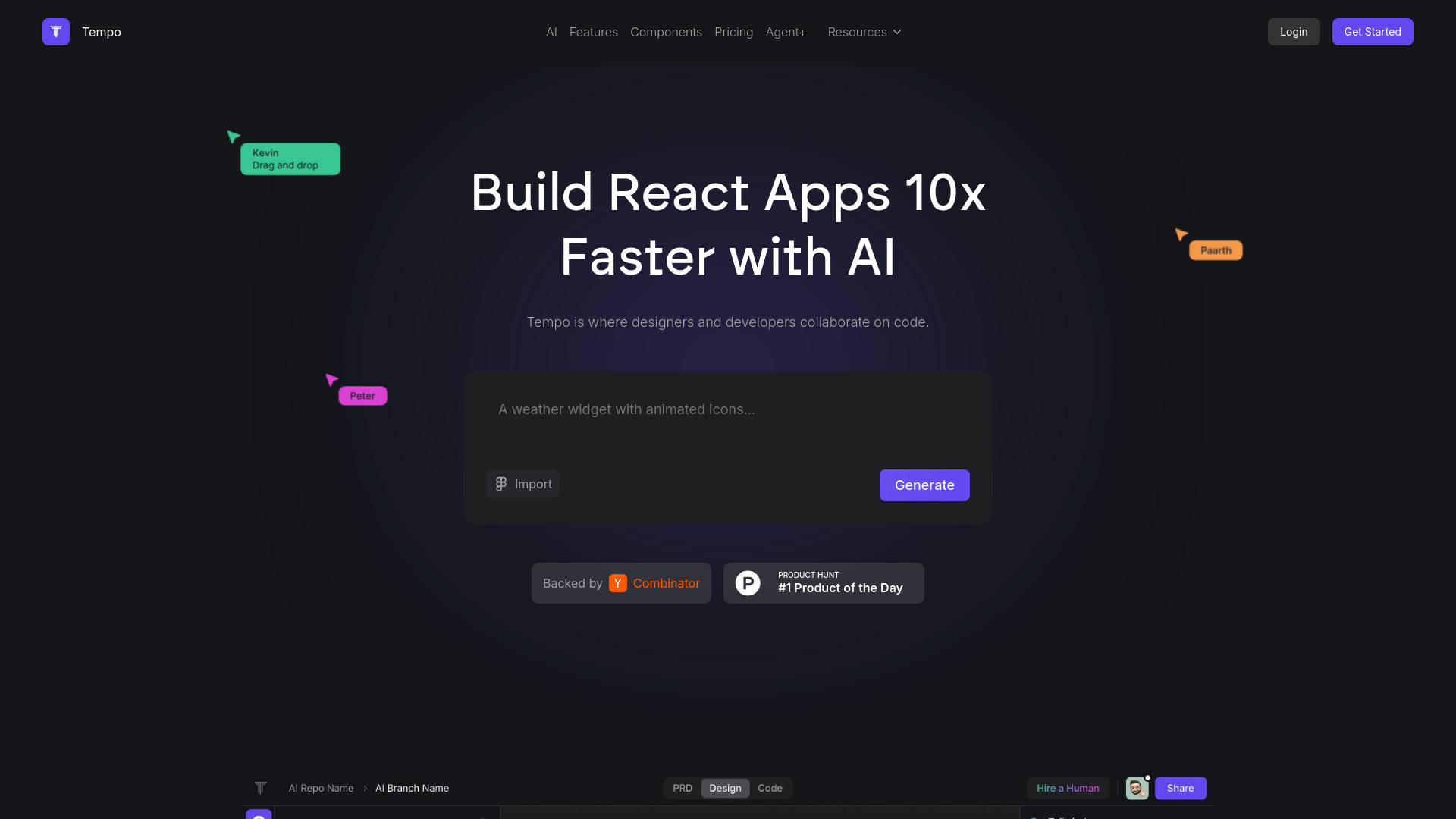- Home
- AI Design Generator
- Tempo

Tempo
Open Website-
Tool Introduction:AI React UI builder to collaborate, import components, ship faster.
-
Inclusion Date:Oct 28, 2025
-
Social Media & Email:
Tool Information
What is Tempo AI
Tempo AI is an AI-assisted development environment for building React applications that helps designers and developers collaborate on production-ready UI. It combines visual design with intelligent code generation, so teams can prompt features, develop components, and design interfaces in one workflow. By importing components and working against an existing React codebase, Tempo AI streamlines design-to-code handoff, reduces repetitive boilerplate, and accelerates front-end delivery while preserving code quality and team conventions.
Tempo AI Main Features
- Visual-to-React workflow: Design interfaces visually and export clean React components without manual translation.
- AI prompting for code: Generate JSX, state logic, and UI variants from natural language prompts.
- Component import: Bring in existing components to extend or recompose, preserving your design system.
- Works with existing codebases: Operates on live React projects, enabling incremental adoption.
- Layout and styling assistance: Suggests responsive layouts and styling patterns to match project conventions.
- Context-aware edits: Uses project context to refactor, add props, and wire data with minimal regressions.
- Collaboration: Aligns designers and developers with a shared canvas and code view for faster iteration.
- Quality controls: Diff previews and review steps help maintain code readability and consistency.
Tempo AI Who Is It For
Tempo AI suits front-end developers, product designers, and full‑stack engineers building React UIs. it's valuable for teams maintaining design systems, agencies delivering client projects quickly, and startups iterating on dashboards, landing pages, or internal tools where rapid, high-quality UI development matters.
Tempo AI How to Use
- Set up a workspace and connect an existing React repository or start a new project.
- Import your design system or reusable components to establish building blocks.
- Open the visual canvas to lay out screens, sections, and component hierarchies.
- Use AI prompts to scaffold components, states, and interactions aligned with project context.
- Refine layouts and styles; map props and data sources as needed.
- Review code diffs, adjust naming and patterns to match team conventions.
- Test locally in your dev environment; fix edge cases and accessibility details.
- Commit changes and open a pull request for team review and CI checks.
Tempo AI Industry Use Cases
E‑commerce teams can assemble product listing grids, filters, and cart panels rapidly while reusing existing components. SaaS companies can generate dashboard layouts and settings forms, then wire data and validation with prompts. Marketing teams can spin up responsive landing sections, hero blocks, and pricing tables with consistent tokens and typography across campaigns.
Tempo AI Pros and Cons
Pros:
- Accelerates React UI delivery with design-to-code automation.
- Respects existing components and project conventions.
- Bridges designer–developer collaboration in a single workflow.
- Context-aware AI reduces boilerplate and repetitive edits.
- Reviewable diffs support maintainable, production-friendly code.
Cons:
- Primarily focused on React; limited value for non-React stacks.
- Requires onboarding to align outputs with team patterns.
- AI suggestions may need refinement to meet accessibility and performance standards.
- Works best with clear component boundaries and established design tokens.
Tempo AI FAQs
-
Does Tempo AI work with existing React codebases?
Yes. It is designed to operate on existing projects, letting you import components and evolve UIs incrementally.
-
Can designers use Tempo AI without writing code?
Designers can assemble layouts visually and use prompts to generate code, while developers review and refine the output.
-
Does it replace my IDE or code review process?
No. Tempo AI complements your tooling by generating and editing code that you can test, diff, and review as usual.
-
Can I import and reuse our design system components?
Yes. You can bring in existing components to maintain consistency and speed up composition.
-
What types of UI can it help build?
Common patterns include dashboards, forms, cards, tables, lists, modals, and responsive landing sections.




